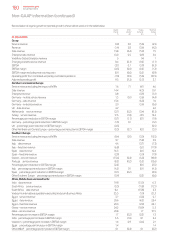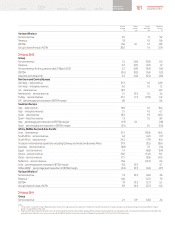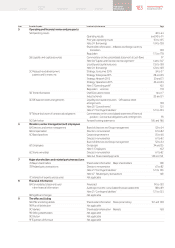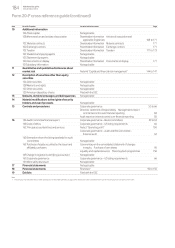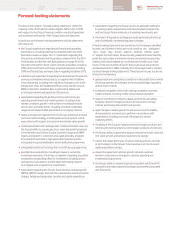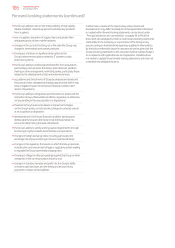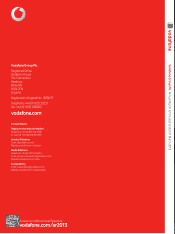Vodafone 2013 Annual Report Download - page 190
Download and view the complete annual report
Please find page 190 of the 2013 Vodafone annual report below. You can navigate through the pages in the report by either clicking on the pages listed below, or by using the keyword search tool below to find specific information within the annual report.
Mark-to-market Mark-to-market or fair value accounting refers to accounting for the value of an asset or liability based on the
current market price of the asset or liability.
Mobile broadband Also known as mobile internet (see below).
Mobile customer A mobile customer is dened as a subscriber identity module (‘SIM’), or in territories where SIMs do not
exist, aunique mobile telephone number, which has access to the network for any purpose, including data
only usage, except telemetric applications. Telemetric applications include, but are not limited to, asset and
equipment tracking, mobile payment and billing functionality, e.g. vending machines and meter readings,
andinclude voice enabled customers whose usage is limited to a central service operation, e.g. emergency
response applications in vehicles.
Mobile internet Mobile internet allows internet access anytime, anywhere through a browser or a native application using any
portable or mobile device such as smartphone, tablet, laptop connected to a wireless network.
Mobile termination rate (‘MTR’) A per minute charge paid by a telecommunications network operator when a customer makes a call
to another mobile or xed line network operator.
MVNO Mobile virtual network operators, companies that provide mobile phone services but do not have their own
licence of spectrum or the infrastructure required to operate a network.
Net debt Long-term borrowings, short-term borrowings and mark-to-market adjustments on nancing instruments
less cash and cash equivalents.
Net promoter score (‘NPS’) Net promoter score is a customer loyalty metric used to monitor customer satisfaction.
Operating expenses Operating expenses comprise primarily of network and IT related expenditure, support costs from HR and
nance and certain intercompany items.
Operating free cash ow
Cash generated from operations after cash payments for capital expenditure (excludes capital licence and
spectrum payments) and cash receipts from the disposal of intangible assets and property, plant and equipment.
Organic growth All amounts marked with an “*” represent organic growth which presents performance on a comparable basis,
both in terms of merger and acquisition activity and movements in foreign exchange rates. From 1 October
2011 theGroup revised its intra-group roaming charges. Whilst neutral to Group revenue and protability,
these changes have had an impact on reported service revenue by country and regionally since 1 October
2011. Whilst prior period reported revenue has not been restated, to ensure comparability in organic growth
rates, country and regional revenue in the prior nancial year have been recalculated based on the new pricing
structure to form the basis for our organic calculations. During the 2013 nancial year, Indus Towers (reported
within the India segment) revised its accounting for energy cost recharges to operators from a net to a gross
basis, to reect revised energy supply terms. The impact of this upward revenue adjustment has been excluded
from reported organic growth rates. The adjustment has no prot impact.
Partner markets Markets in which the Group has entered into a partner agreement with a local mobile operator enabling
a range of Vodafone’s global products and services to be marketed in that operator’s territory and extending
Vodafone’s reach into such markets.
Penetration Number of SIMs in a country as a percentage of the country’s population. Penetration can be in excess
of 100% due to customers’ owning more than one SIM.
Petabyte A petabyte is a measure of data usage. One petabyte is a million gigabytes.
Pps Percentage points.
Reported growth Reported growth is based on amounts reported in pound sterling as determined under IFRS.
RAN Radio access network is the part of a mobile telecommunications system which provides cellular coverage
to mobile phones via a radio interface, managed by thousands of base stations installed on towers and
rooftops across the coverage area, and linked to the core nodes through a backhaul infrastructure which can
be owned, leased or a mix of both.
Retention costs The total of trade commissions, loyalty scheme and equipment costs relating to customer retention
andupgrade.
Roaming Allows customers to make calls on other operators’ mobile networks while travelling abroad.
Service revenue Service revenue comprises all revenue related to the provision of ongoing services including, but not limited
to, monthly access charges, airtime usage, roaming, incoming and outgoing network usage by non-Vodafone
customers and interconnect charges for incoming calls.
Smartphone devices A smartphone is a mobile phone offering advanced capabilities including access to email and the internet.
Smartphone penetration The number of smartphone devices divided by the number of registered SIMs, excluding data only SIMs.
SME Small to medium-sized enterprises.
SoHo Small-ofce home-ofce.
Spectrum The radio frequency bands and channels assigned for telecommunication services.
Supranational An international organisation, or union, whereby member states go beyond national boundaries or interests
to share in the decision-making and vote on issues pertaining to the wider grouping.
Tablets A tablet is a slate shaped, mobile or portable casual computing device equipped with a nger operated
touchscreen or stylus, for example, the Apple iPad.
VZW Verizon Wireless, the Group’s associate in the US.
VZW income dividends Distributions (other than tax distributions) by Verizon Wireless as agreed from time to time by the Board
of Verizon Wireless.
VZW tax distributions Specic distributions made by the Cellco Partnership to its partners based on the taxable income
of VerizonWireless.
Denition of terms (continued)
188 Vodafone Group Plc
Annual Report 2013




